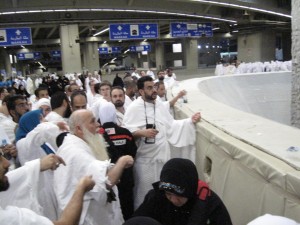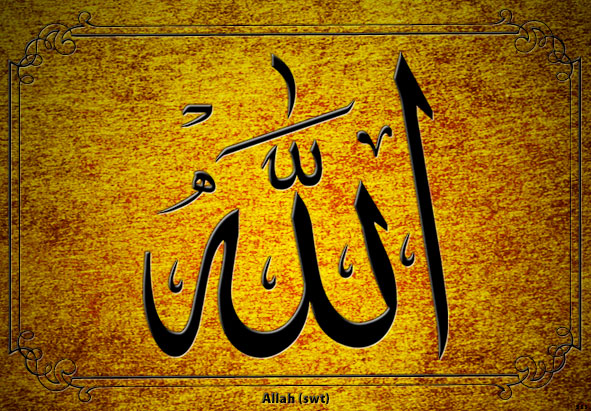
The story of Prophet Ibrahim, his wife Hajar, and Prophet Ismail symbolises pre-eminently the awesome submission to the will of Allah by the three believers and the limitless Compassion and Mercy of Allah Who accepted a goat as a ransom for the life of Nabi Ismail.
These symbols of human submission and Divine Mercy prefigure the Hajj ritual. And Allah reminds us in Sura Hajj, verse 78 that He “…has placed no difficulties on you in matters concerning religion (Haj : 78). Further reminders abound. In another verse Allah says : “Allah desires for you ease; He does not desire hardship for you” (Baqara : 185). So it goes on to the extent that hundreds of years ago Muslim scholars developed a Fiqh principle called “al-Mashaqqah Tajlibu at-Taysir” (difficulties demand leniency in the application of Fiqh). A whole host of Islamic legal rulings based upon this principle – and as evidenced by the prophet Muhammad’s application himself – are applied throughout the Shariah. In the Salaah, for example, if for any valid reason you cannot stand, then you can sit. If you cannot sit then you can lie down. The Prophet (SAW) – eminently reflecting the Divine Will – also said : “If I order you to do something then do only that which is within your capacity to do”. We are simply not expected to perform beyond our capacities for Allah Himself “does not burden anyone beyond his capacity” (2 : 286).
What is the relevance of all of this with regard to our Haj? This year once again we have witnessed grotesque scenes of horror as more than a hundred pilgrims were stampeded to death on the bridge at Mina after Zawaal (noon). Hundreds more were injured. In 1994 270 people were killed at the same spot. All of this happened despite the best efforts of those responsible for organizing the Haj. Medical, structural, and other material conditions have been improved to a remarkable extent. After the 1994 stampede the Mina bridge was doubled in width. Yet disaster struck again. My view with regard to this is that the challenges which confront Muslim scholars are quite obvious. Are we prepared, with equal diligence, to expend our resources in generating legal rulings to levels which are qualitatively and creatively above those to which we are accustomed? The Washington Post of Thursday, April 9, 1998 notes in an article entitled “Mecca Pilgrims Stampede : 150 Dead”, that “Islamic tradition forbids pilgrims from throwing the pebbles before noon”. The sources of this correspondent are probably Muslim scholars. Whose or what “tradition” is being referred to by the writer? My reading of the issue has indicated to me that it is the majority view of our classical scholars that the throwing of the Jamaraat ought to be done after Zawaal. There is nothing, however, in my readings which indicates to me that it is prohibited in any absolute sense to throw before Zawaal or after Fajr, or for that matter after Maghrib. For our own sakes let us turn to some opinions stemming from our traditional sources.
According to Tawus ibn Kisan and ‘Ata ibn Abi Rabah (the Muftis of Yemen and Makkah respectively immediately after the era of the Companions which ended approximately 100 years after Hijra) it is permissible without any conditions to throw the pebbles after Fajr. This is furthermore the opinion of two of the greatest scholars known to the Shafite school of thought viz. Imam ar-Rafi’ and Imam al-Asnawi. Identical views are shared by the renowned Hanbalite scholar Ibn al-Jawzi and the son of Syedna ‘Ali ibn Abi Talib, Abu J’afar Muhammad ibn ‘Ali.
In addition to the above there are a number of scholars who have supported the permissibility of throwing before Zawaal subject to certain conditions. This ruling is based on the Hadith related by Daraqutni that “the Prophet of Allah allowed those tending to the camels to throw their pebbles at night or anytime during the day”. These scholars are of the view that if “tending to the camels” can act as a reason for throwing the pebbles at any time during the day then reasons such as sickness and fear for one’s life and money must by the same (or greater?) token act as equally valid reasons for a similar ruling. Furthermore there is not a single Hadith – apart from the fact that the Prophet himself threw after Zawaal – which categorically states that to throw before Zawaal or even after Maghrib is expressly forbidden. What the Prophet (SAW) did at a particular moment does not necessarily invalidate doing the same act at another moment. Unless of course there is additional proof to show otherwise. The Prophetic saying : “Take from me the Manaasik (rites) of Haj” is simply not sufficient proof to endorse the “obligation” of having to throw after Zawaal. The term “Manaasik” includes the Waajibaat (obligatory directives), the Mustahabbaat (strongly recommended acts), and Sunnahs of the Prophet. The implications of this Hadith definitely need to be re-examined. What we do know, however, is that a particular person came to the Prophet and said to him (SAW) : “I threw the Jamaraat during the evening”. The Prophet’s reply was : “Perform your rites (as you deem fit) for there are no difficulties in the Haj”. The term Masa in the Arabic of the above Hadith includes both the latter part of the afternoon and part of the evening after Maghrib. Another telling point is the fact that in both the Shafi’ and Hanbali schools of thought permission is given to throw all one’s collected pebbles on the third day of Tashriq without the necessity of paying a penalty for missing out on the first and second days. Why the insistence – particularly today – on having to throw the pebbles after Zawaal mystifies me. One can understand why the majority of classical scholars ignored the fact, or at least did not find it necessary, to debate the matter in any extensive manner.
The question of stifling numbers was simply never an issue. Statistics suggest that fifty years ago only 10,000 people perfomed Haj. That number has since multiplied twenty thousand-fold to include an average of 1.5 to 2 million Muslims during the nineties. It is the potential hazards of these numbers that has prompted a number of contemporary scholars (both locally such as the late Sh. Mahdi Hendricks and internationally) to seek a Shari’ solution to the problem. It is difficult to imagine a majority being upheld in the light of this latest explosion in the Haj population. It is even more difficult to imagine our Prophet (SAW) smiling in prophetic approval at the carnage that has become part of a sacred ritual. How on earth, one might well ask, do we receive the Prophet into our hearts – a Prophet who is described in the Quran as the Prophet of compassion and mercy. Yet there will be those, speaking in the name of the Prophet and Islam, who will still maintain that to throw after Zawaal is more “spiritual” and more in line with the mood of the Haj; and, by similar twists of emotional twaddle condemn unsuspecting, ordinary, and often very sincere people to a high risk of terminating their lives. Others might well shout that Paradise is indeed their well-deserved lot. And so it might be. But what about those of us who are partly responsible for sending these people to an avoidable catastrophe? Are we prepared to handle the consequences of having converted the bridge of Mina into an unofficial death row? But perhaps another example from the Prophetic model might serve to remove the obfuscations of a counter-productive emotional piety which has become the daily diet of Muslims around the world. Daraqutni and Abu Dawud recorded a Hadith which relates the case of a man who injured himself with a stone and later on required a ghusl (full ceremonial ablution). The man was advised by his companions that there was no reprieve for his condition and that he had to take the full ablution with water despite his injuries. The man did as he was told and a while later he died. When the Prophet (SAW) came to hear of the matter he was infuriated. He said : “They have killed him. May Allah in turn kill them. Do they not ask when they do not know? The remedy for those who are confused is to ask! It would have been sufficient for that man to perform Tayammum (dry ablution), bandage his wound, then to rub on it, and only thereafter wash the rest of his body”. This is the spirit of the Prophet of compassion and mercy – a Prophet who refused to allow an ill-conceived pietism to obscure the higher objectives and purposes of the Shariah.
One cannot but notice how this tragedy perverts the universal message of peace associated with Hajj. Reports and images were beamed worldwide of agony and death from the very heart of this message. Can we only look in horror? Or, worse still, do we accept this as symptomatic of a much deeper malaise in our thinking? Are we in the process of generally legislating our Din to death? The answer to all of these need not be in the affirmative. What is required of us however, is to produce a matrix of Fiqh – without sacrificing our great classical heritage – that would allow us to take cognizance of present realities. Furthermore – and more relevant to our purpose here – while we need not fool ourselves into believing that there are easy solutions to the problems at the Jamaraat in Mina, there can be little doubt that a broader acceptance of the view that it is permissible to throw before Zawaal or after Maghrib would indeed go a long way in in fulfilling one of the six universal principles of Islam viz. the protection of life. After all, the pelting of the Jamaraat is one of the most meaningful symbolic rituals known in Islam – the act of rejecting all forms of peversity, whether of the human or satanic order. Maybe it is time for us too, in equally symbolic fashion, to turn those pebbles upon our own rigid attitudes, often cast -and disconcertingly so – in hard stone.
(This article was originally published in the “Muslim Views” April 1998 under the heading “The tragedy behind the carnage in Makkah”.)
(c) copyright 2015 al-Zawiyah



